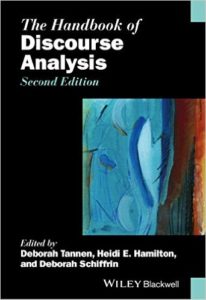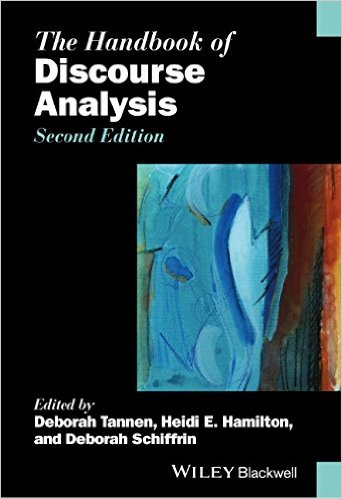The Handbook of Discourse Analysis , edited by Deborah Tannen, Heidi Hamilton, and Deborah Schiffrin, 2 vols. (Wiley Blackwell, 2015), 952 pages.
, edited by Deborah Tannen, Heidi Hamilton, and Deborah Schiffrin, 2 vols. (Wiley Blackwell, 2015), 952 pages.
Several handbooks on discourse analysis have been published recently. To gain a little perspective, Brown and Yule’s Cambridge Textbook on discourse analysis was published in 1983. In this short 30 years, the field of discourse analysis is now increasingly specialized such that handbooks are being published left and right.
The first edition to this handbook was published in 2001. It is been used widely, so much so that this second edition was issued only 14 years later. It follows shortly after the Routledge Handbook of Discourse Analysis (2012) and the Bloomsbury Companion to Discourse Analysis (2013). Textbooks also arise rapidly from all different kinds of perspectives, ranging as wide as the topics addressed in this handbook.
Content
The editors believe this diversity within the field is a strength rather than a weakness, and they intend this handbook to foster “the cooperative use – by linguists and others interested in empirically grounded studies of language – of the many theoretical and analytical resources currently proliferating in the study of discourse” (5). As I said in my review of the Routledge volume, I found it to be the most helpful for non-specialists or beginning linguists, while this Blackwell volume is the best volume for specialists because of its breadth and clear aim to write for professional linguists.
There are four parts to the set, 2 parts in each volume: (Linguistic Analysis of Discourse; (2) Approaches and Methodologies; (3) The Individual, Society, and Culture; (4) Discourse in Real-World Contexts. Biblical studies students will find the first two parts most helpful, since it focuses on method different applications of discourse analysis to various fields. Much can be learned in these essays that can be applied to one’s own method. However, not all the articles are useful, since many of them analyze oral speech (e.g., “Voice Registers,” ch. 5; “Humor and Laughter,” ch. 8; etc.). This volume is certain to help many, but not many of the articles are certain to help all readers.
The second volume should not be ignored, however. The application of discourse analysis to cultural issues and real-world contexts is still useful to those of us who remain buried in ancient texts. We still live in a world swirling with political discourse (ch. 36); we participate in institutional discourse (ch. 35); we have a workplace (ch. 41); we are constantly interacting with the media (ch. 37). And then there are chapters such as “Queer Linguistics as Critical Discourse Analysis” and the chapter on Critical Discourse Analysis by world-renowned Teun A. van Dijk that can be helpful for interacting with certain segments of the biblical academy that focuses on similar issues.
Problems
There are two main downfalls to these volumes. First, there is no methodology laid out by any of the practitioners. Consistently, the only times I see any method somewhat laid out is in chapters on Systemic Functional Linguistics, when the author analyzes a text using Halliday’s categories. Even then, the author is not teaching the method, but only exemplifying it. This is a consistent problem with works on discourse analysis: everyone is left to do what is right in their own eyes.
Second, the price is simply not affordable for individuals. While these volumes will make it into many institutional libraries across the world, I doubt anyone reading this will be willing to spend the cash required to purchase it. However, a significantly cheaper paperback version of the first version was published two years after the hardback version. So perhaps Blackwell has a paperback version in the works. If so, then as soon as it comes out, I would recommend purchasing it, even the first edition still runs around $70 for the paperback volume.
Finally, for more resources on discourse analysis, see our annotated bibliography.
Find it here on Amazon and preview the table of contents.

